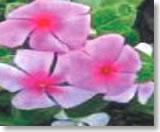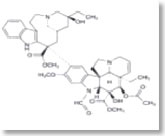
SADA PUSHPI
Botanical Name: Vinca rosea ( APOCYNACEAE)
English Name: Madagascar Periwinkle
Hindi Name: Sadabahar, Sada suhagan

Introduction: This is introduced to Indian Medicine in the recent era. Ancient texts of Indian Medicine did not mention this. V. rosea is a native North American plant which attracted the scientists first with its anti-diabetic property and now world-wide recognized for its anti-cancer activity.
Distribution: A native plant of West Indies and now a days cultivated in gardens.
Chemical Constituents: Vincristine, vinblastine, ajmaline, catharanthamine, leurosidine, leurosine etc.
Parts Used: Leaves and Flowers.
Properties: Bitter, heat producing, anti-cancer, anti-diabetic etc.
Indications: Cancer, diabetes mellitus.
Dose: Flower powder 1-2g and leaf powder 2-4g/day.
Therapeutic Uses:
- Diabetes: Its flowers are given orally at a dose of 1-2g twice daily.
- Abdominal pain: Leaf or whole plant powder is given with leukwarm water.
Scientific Studies:
Anticancer activity: Vinblastine, vincristine, leurosidine and leurosine are oncolytic alkaloids and are effective against P-1534 leukaemia in DBA/2 mice.
Vinblastine is particularly used to treat Hodgkin’s disease beside lymphosarcoma, choriocarcinoma, neuroblastoma, carcinoma of the breast, lungs and other organs in acute and chronic leukemia.
Vincristine arrest mitosis in metaphase and is very effective for the treatment of acute leukaemia in children and lymphocytic leukemias. It is also used against Hodgkin’s disease, Wilm’s tumour, neuroblastoma, rhabdosarcoma and reticulum cell sarcoma.
Catharanthamine, leurosidine-Nb-oxide and 16-epi-Z- isositsirikine are cytotoxic in the KB test system in vitro and show anti-tumour activity against P-388 lymphocyctic leukaemia (Chopra, W.I. Vol. 3).
Anti-hypertensive activity: The total alkaloids and chloroform fraction showed significant and sustained hypotensive activity ( Chora, W.I. Vol. 3).
Anti-spasmodic activity: The alkaloids caused relaxant and antispasmodic effect on the smooth muscles of the intestine and uterus, and direct myocardiac and CNS depression ( Chopra, W.I. Vol.3).
Cultivation Technology: The plant is suitable for all types of soils from fertile fields to barren soils. It is easily propagated through seeds or cuttings. 10-15 cm long cuttings with at least 2-3 internodes are planted in poly bags or directly in the fields. Rooted stem cuttings are transplanted to the main plots at the distance of 30x30cm. Irrigate the field immediately after transplanting and later as and when required.
Harvesting: As it is perennial crop, matured leaves and flowers are collected at periodic intervals.







